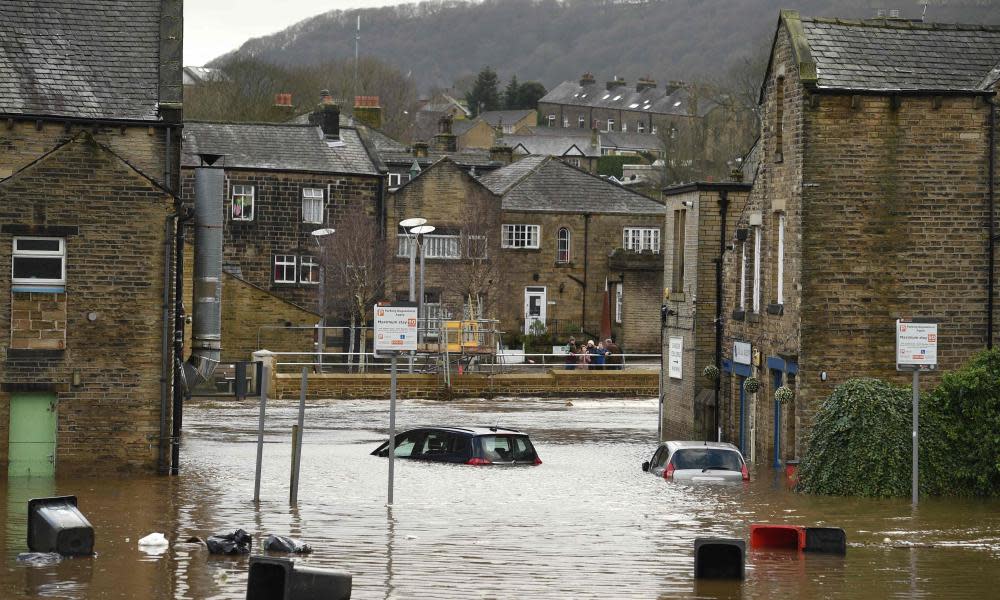End housebuilding on flood plains – Labour

Labour has called for an immediate end to building houses on land at high risk of flooding following the worst winter storms in years.
The Guardian revealed on Sunday that more than 11,000 homes were planned in areas the government considers a high flood risk in the seven English regions swamped by Storms Ciara and Dennis.
Luke Pollard, the shadow environment secretary, said he would press ministers on the issue when parliament returns from recess on Monday: “The climate crisis means we have to do things differently. One quick win after these latest floods is for a genuine end to building homes on flood plains.
“With more severe weather happening more often we now need a new plan for flooding and that can start today with ministers agreeing with Labour that it is time to end building homes on flood plains.”
Ministers are facing renewed calls to review the government’s housing strategy as experts, local authorities and insurers warn that building on flood plains is increasing the danger to thousands of people from extreme weather, which climate scientists say will become more commonplace.
The government aims to build 300,000 homes a year by the mid-2020s to help ease a chronic housing shortage across the UK. Yet local authorities say they are struggling to meet these demands because of a dearth of available land, leading to as many as one in 10 new homes being built on high-risk flood sites since 2013.
Boris Johnson suggested in December that building on flood-prone land must stop, saying on an election campaign visit in flood-hit Derbyshire: “We’ve got to stop building on flood plains. We’ve got to stop building on areas which are vulnerable to flooding.”
But that does not appear to have been a formal policy announcement and would have major implications for the government’s ambitious housing targets. Nearly 20,000 houses were built on land at high risk of flooding – 9% of the total – in 2017-18, according to the latest official figures.
The environment secretary, George Eustice, is expected to be questioned by MPs later on Monday amid criticism of the government’s response to the storms, which have left thousands of homes and livelihoods in ruins.
Johnson has been accused of failing to grasp the scale of the damage caused by one of the wettest Februarys in 254 years of records, and criticised for not calling an emergency Cobra meeting that would have speeded up the release of vital recovery funds to the areas hardest hit.
Nine days after Storm Ciara, the government invited flood-stricken residents and businesses to apply for up to £500 in “financial hardship payments”, council tax and business rates relief, and access to funds of up to £2,500 to cover some uninsurable losses. Ministers also said flood-hit homes and businesses would be able to apply for up to £5,000 to “help make them more resilient to future flooding”.
A joint investigation by the Guardian and Greenpeace’s Unearthed news unit found that of the 11,410 new homes planned across seven flood-stricken English authorities, 1,479 are in four of the areas hit hardest by Storms Ciara and Dennis: Calderdale, Herefordshire, Shropshire and Worcester. The government defines high-risk areas as having a 1% or greater chance of flooding in any year.
In Shropshire, where a severe weather warning remains in place – meaning an imminent danger to life – 764 homes are set to be built in areas with a high flood risk. In Doncaster, where the Fishlake area was flooded in November, nearly 4,000 homes are intended for such flood zones.
The Environment Agency said flooding of properties was expected to continue this week as a further band of rainfall sweeps across Britain. Nearly 96 flood warnings, meaning flooding is expected, are in place across England from Dorset to Cumbria on Monday, along with a further 184 alerts meaning flooding is possible.
A spokesman for the Ministry of Housing, Communities and Local Government said: “Local authorities have a responsibility to assess the number of homes their communities need, and our planning policy is clear that housing should be located in the areas at least risk of flooding. Where development in a risk area is absolutely necessary, sufficient measures should be taken to make sure homes are safe, resilient and protected from flooding.”


